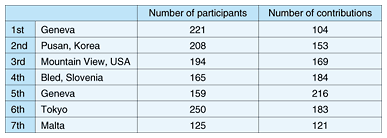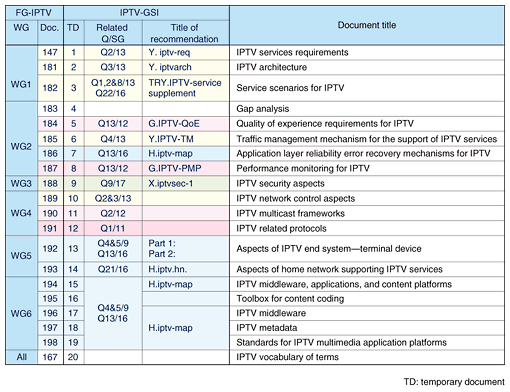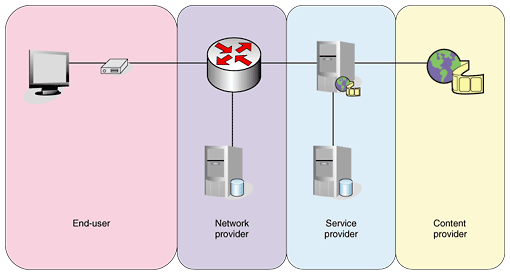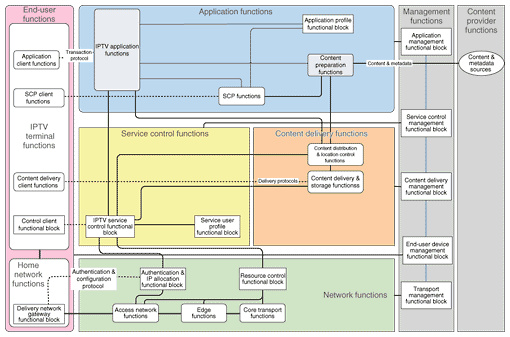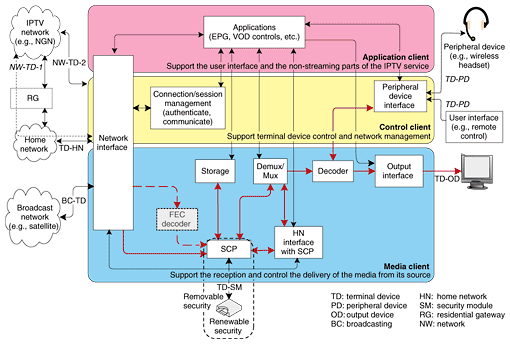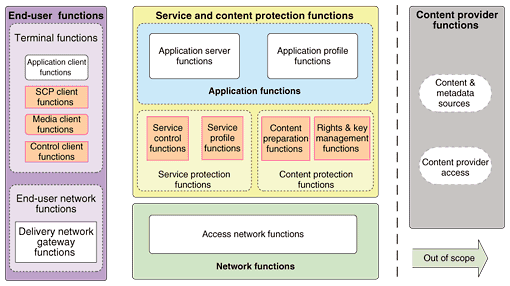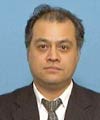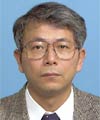 |
|||||||||
|
|
|||||||||
|
Global Standardization Activities Vol. 6, No. 8, pp. 40–47, Aug. 2008. https://doi.org/10.53829/ntr200808gls Report on ITU-T FG IPTV International Standardization ActivitiesAbstractIn this article, we introduce the results of the activities of the Focus Group on Internet protocol television (FG IPTV) and plans for future standardization by ITU-T (International Telecommunication Union, Telecommunication Standardization Sector) related to IPTV. FG IPTV was established in July 2006 to promote international standardization of IPTV, and the deliverable documents were completed in December 2007.
1. Overview of FG IPTV activitiesThe Focus Group on Internet protocol television (FG IPTV) was established at the ITU-T (International Telecommunication Union, Telecommunication Standardization Sector) consultation conference in April 2006 in recognition of the need to investigate various topics related to IPTV standardization, including IPTV interoperability and an analysis of the differences among regional standards. Seven meetings were held from July 2006 to December 2007, in which more than 1100 Contributions were discussed and 20 deliverable documents were completed. The locations, number of participants, and number of Contributions for all seven meetings are listed in Table 1.
To cover all of the study items concerning IPTV provision, the FG IPTV was composed of six Working Groups (WGs), as listed in Table 2. One FG Chairman (Canada) and three FG Vice Chairmen (Korea, China, and the UK) were elected. From Japan, Yoshinori Goto from NTT Access Service System Laboratories was elected to lead WG5 and Masahito Kawamori from NTT Cyber Solutions Laboratories was elected to lead WG6.
The NTT Group has proceeded with IPTV international standardization on the basis of discussions with other domestic IPTV service providers and with consumer audio/visual electronics manufacturers, broadcasters, etc. The deliverable documents of the FG IPTV are listed in Table 3. They served as input to SG13, the FG's parent Study Group (SG), which passed each document on to the appropriate SGs. The FG deliverable documents were considered by multiple SGs in order to produce Recommendations. To promote greater efficiency in producing IPTV Recommendations, a group called IPTV-GSI (IPTV Global Standards Initiative) was established. IPTV-GSI discussed relevant Questions at meetings held at the same time and place as WG/SG meetings. The relevant Questions and SGs, draft Recommendation names, and document titles for the deliverable documents are listed in Table 3. We studied WG1 and WG4 documents in close cooperation with ITU's FG on NGN (Next Generation Network) [1]. To obtain the cooperation of the relevant SGs in studying the deliverable documents listed in Table 3 to produce Recommendations, a total of five IPTV-GSI meetings were scheduled for 2008, and discussions by the various SGs have centered on them.
The FG IPTV meetings were open to outsiders as well as to ITU members, and the Contributions and Reports can be found on the ITU-T web site [2]. The deliverable documents have been collected and published as proceedings [3]. 2. IPTV study model and architectureIPTV is defined as “multimedia services such as television/video/audio/text/graphics/data delivered over IP-based networks managed to provide the required level of QoS/QoE, security, interactivity and reliability” (QoS: quality of service, QoE: quality of experience). On the basis of that definition, study has proceeded with an IPTV domain model comprising the four domains of content providers, service providers, network providers, and end users (Fig. 1). Of those domains, the three other than the content providers focus on the overall IPTV provision functions and have produced an IPTV architecture diagram (Fig. 2). Three implementation approaches of network are assumed: (1) NGN-IMS, in which IMS (IP Multimedia Subsystem) is used for the session control function on the NGN, (2) NGN-non-IMS, in which the existing service control function is used on the NGN, and (3) non-NGN for the existing network. Sections 3 to 5 describe terminals that have middleware for operating in this architecture, the QoE requirements for IPTV services and control functions, and content protection, which is important to content providers.
3. Terminals with middlewareIPTV terminals are described in the WG5 IPTV end-system-terminal and home network documents. A conceptual diagram of the terminal is shown in Fig. 3. Study is proceeding on the premise of IPTV-compatible TVs (mainly with set-top boxes), dedicated terminals, and mobile terminals. The terminal document specifies the requirements for IPTV services discussed by WG1 and the terminal functions that are required to implement them on the basis of service scenarios. Specifically, they include a function for video decoding and output, a function for receiving emergency reports, and three types of personal video recorder (PVR) functions. The documents describe the three PVRs: a network PVR (nPVR), a terminal-side client PVR (cPVR), and a distributed PVR (dPVR), as well as various terminal functions such as remote operating status monitoring and maintenance.
Concerning the internal terminal middleware, WG6 checked on the middleware being used in each country and produced a deliverable document entitled IPTV Middleware. International standardization of the functions of terminals that contain middleware should lead to a reduction in the price of IPTV terminals. 4. QoE and QoSQoE was dealt with by WG2. QoE is defined as “the overall acceptability of an application or service, as perceived subjectively by the end-user” in an appendix to ITU-T Recommendation P.10/G.100. WG2 gave definitions of the quality of video and audio, which are IPTV services received over continuous long-term viewing, network quality, TV service control function quality, the time required for channel switching, and delays related to video-on-demand (VOD) control functions (called trick modes: fast forward, slow forward, slow rewind, and fast rewind, etc. are possible) and there are also descriptions of measurement criteria for these various types of quality. The service quality is also defined for other optional IPTV services such as channel selection and electronic program guides (EPGs). Specific descriptions are given below. 4.1 QoE for video and audioQoE requirements for video and audio originally had to be specified using subjective scales for the service user, such as MOS (mean opinion score) or DSCQS (double stimulus continuous quality scale), which are recommended in ITU-R BT.500-11. Because such subjective quality measurement is time-consuming and expensive, objective quality criteria, which are based on monitoring the video signal level and/or IP packet transfer performance, are specified. The WG2 deliverable document therefore defines objective quality metrics related to video and audio compression and encoding as well as audio and video synchrony. It must be noted that the values of these objective metrics depend on the type of compression and encoding used and on advances in technology. 4.2 Network layer performanceTo enable the QoE requirements to be achieved, the documents describe network layer performance, an application-level error recovery function (forward error correction, interleaving, etc.), and a mechanism for mitigating encoding loss (decoding error concealment). As network layer performance items, they also describe packet transmission delay and jitter, packet loss rate, and packet loss distance, which is the time interval of packet loss events. 4.3 QoE for control functionsThe requirements for channel zapping (frequent channel switching with the remote control while viewing TV) and VOD trick modes are described. For channel zapping, the documentation gives a definition and describes three components: IGMP (Internet group management protocol) delay, buffering delay, and decoding delay. For the trick modes, it gives definitions and describes the delay associated with these modes. 4.4 QoE for other IPTV servicesIPTV services also involve EPGs, browsers, and content navigation functions. These are also described in term of functions and are important to the overall QoE of IPTV services, so the need for future study is stated. In addition to the QoE requirements mentioned above, FG-IPTV also describes quality monitoring methods and functions for maintaining the quality of the network and applications. NTT believes that it is important to implement IPTV services with suitable video and audio quality and provide excellent operability and functionality with remote controls and other such devices. Considering that viewers will spend a lot of time with their TVs in the future, we believe that it is important to promote standardization of terminal operability and the requirements for the QoE of other services as well. 5. Content protectionIPTV service enterprises distribute content on the basis of contracts with the content rights holders. It is therefore necessary for the distributor to restrict viewer use of the content to within the scope of these contracts. ITU-T is also deliberating issues related to content protection and IPTV service protection. The heart of IPTV content protection is SCP (service and content protection). This includes the same functions as CAS (conditional access systems) and DRM (digital rights management), which are widely used in broadcasting and thus familiar to content rights holders. The concept of content protection is illustrated in Fig. 4. SCP comprises an SCP client function for terminals, etc. and a content protection function and a service protection function for the transmitting side. The content provider function does not directly control the terminal; it delivers business-to-business (B2B) content-usage conditions, etc., so it is outside the scope of standardization. The two main functions of SCP—content protection and IPTV service protection—and other SCP-related functions are explained below
5.1 Content protection functionThe content protection function comprises functions for (1) content encryption and decryption, (2) transmission of the keys required for encryption and decryption, and (3) secure distribution of content-usage conditions. 5.2 IPTV service protection functionFor IPTV services protection, the document describes (1) secure addition and improvement of SCP functions, (2) functions for adding and updating IPTV services, such as the addition of new terminal functions, and (3) a function for confirming that the receiver is being used by a viewer who has been authorized to receive IPTV services through SCP authentication. 5.3 Other security functionsAnother SCP-related security function, an optional digital watermarking function, is currently being prepared. Digital watermarking is a technique capable of handling the problem of unauthorized copies that violate the content-usage conditions by enabling such copies to be tracked. However, it leads to an increase in receiver costs and only suppresses unauthorized use rather than preventing it, so there are problems with respect to cost effectiveness. Furthermore, while discussions that assume the transfer of content to portable music players for private use are in progress, that is not a service that IPTV service operators will provide directly and diverse methods exist for this function at the present stage. Therefore, this function is not subject to standardization, and the functional items are listed in an appendix. 6. Future standardization related to IPTVThe broadband environment in Japan, which includes fiber to the home (FTTH), is more extensive than those in other countries, and the country is ready for the deployment of IPTV services. Japan is ahead of other countries in many respects, including IP retransmission of digital terrestrial broadcasting over the NGN (by the NTT Group) and the provision of IPTV services. On the other hand, de facto standards that suit the conditions in various countries and regions abroad are being studied. To avert a flood of multiple standards and to ensure interoperability of standards in the future, it is important for ITU-T to establish standards as soon as possible while considering compatibility with de facto standards. Most of the FG deliverable documents are planned to be made into ITU Recommendations by the end of 2008. Toward that end, we are establishing domestic organizations such as the Special Committee on IPTV set up by the Ministry of Internal Affairs and Communications in March 2008. In the future, the NTT Group will continue to make proposals suitable for actual business and contribute to the early adoption of Recommendations related to IPTV. References
|
|||||||||








